![]()
Passing From Light Into Dark
John F. McClymer
Part 1 | Part 2 | Historiographical Essay
[Note: This discussion began as a paper, co-authored with Charles W. Estus, Sr., for a conference at the Immigration History Research Center at the University of Minnesota, Twin Cities, in 1996. It grew out of our work, supported by a Public Programs grant from the National Endowment for the Humanities, in curating an exhibition on "The Swedish Creation of an Ethnic Identity for Worcester, Massachusetts" at the Worcester Historical Museum. That paper looked at how Swedes appropriated other racial and ethnic identities as ways of affirming their own American and Swedish-American identity. In its present form, "Passing from Light into Dark" incorporates much of the evidence and argument of that early version but looks beyond Worcester and Swedes.
"Passing from Light into Dark" is a companion to a discussion of The KKK in the 1920s. Both deal with race, ethnicity, and nationality as foci of the "culture wars" of the 1920s. "The KKK in the 1920s" looks at politics, broadly defined. "Passing" looks at culture, defined equally broadly. Both argue that pre-emptive attempts to define who was or was not a real American, so characteristic of the years immediately following World War I, failed, despite such significant initial successes as Prohibition, immigration restriction, and the Red Scare. At the same time, racial boundaries held firm. The failure to limit "real" Americans to those of "Nordic" stock is of a piece with the success in excluding people of color.
In making this argument, I have taken issue with a number of historians from whom I have also learned much. I have decided to put the historiographical discussion into a separate appendix rather than carrying it on in footnotes, as is the more common practice. This is because of the extended nature of the discussion.
I would like to acknowledge the contributions of Charles Estus to this essay and also the suggestions of Lucia Knoles and Gerd Korman. All are friends as well as colleagues.]
In
1917, just on the eve of the American entry into the war, the Norton Company of
Worcester, Massachusetts, the largest manufacturer of industrial abrasives in
the world, put on its annual Minstrel Show. The performers were Norton employees,
many of them first and second-generation immigrants. Swedes formed by far the
largest single group within the company's workforce. The show was part of the
company's Americanization campaign, itself part of Norton's overall practice of
welfare capitalism. Norton sponsored baseball, basketball, and other teams; it
organized garden shows, an annual Folk Festival, employee picnics and outings;
it provided company facilities for a camera club and for a pig club; it published
a company newspaper, The Norton Spirit. It pioneered
safety and industrial medicine measures. And it staged an annual Minstrel Show
which involved scores of Norton workers as singers, dancers,
and comedians. Others worked on sets and costumes, sold tickets, and did other
tasks, such as publicity. [1]
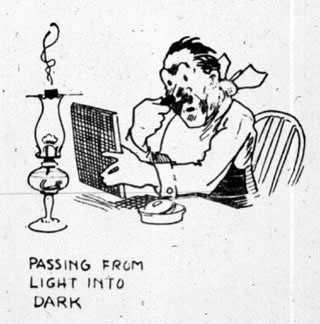
Source:
"Passing from Light into Dark" was the caption of a cartoon in a special issue of the Spirit promoting the show. "Passing" normally referred to African Americans seeking to live as whites. It was, both in this sense and in the ironic sense intended by the Norton Spirit artist, a basic trope of American popular culture. "Showboat" is a prominent case in point. Universally acknowledged as the first great American musical, it fused story and music as it explored the meaning of race and racism. Central to the plot is the attempt of Julie, the "greatest leading lady on the river," to "pass." [2]
As
the curtain rises, she is successful, happily married to a white man who knows
her racial origins, and best friends with Magnolia, daughter of the showboat's
owner, Cap'n Andy. But, a member of the crew learns her secret and threatens to
reveal it unless she sleeps with him. She refuses, and he seeks out the local
sheriff � the boat has stopped at a Mississippi town. Her husband finds a way
of warding off charges of miscegenation; he pricks Julie's finger and then his
own. They press their fingers together. When the sheriff arrives, he informs him
that "I got nigger blood in me." "One drop of nigger blood makes you a nigger
in Mississippi," the sheriff observes and then orders Cap'n Andy not to put on
any shows with a racially mixed cast. Julie and Bill, her husband, leave the showboat.
Magnolia, distraught at what has happened to her friend, tries to go with them.
"Julie was my best friend" before the revelation of her African-American ancestry,
Magnolia cries, "and she hasn't changed." "Of course she hasn't," Cap'n Andy agrees.
Source:
"Showboat" challenged all of the settled beliefs about race. Almost miraculously, it persuaded white audiences to empathize with Julie, to echo Magnolia's cry that Julie was still the same person she had always been, and to applaud Cap'n Andy's view that such a cry proved Magnolia was "a damn fine girl." Yet Julie's story ends unhappily. Alone, alcoholic, and in despair, she sees Magnolia years later in Chicago. She keeps her presence hidden but does Magnolia one last good turn by sacrificing her own chance at employment as a singer. Passing from dark into light ends in tragedy. This was the received wisdom of the day, and it provided the context within which all of the variations on passing from light into dark detailed here took place.
Minstrels Are We
What sort of Americanization effort was a minstrel show? Norton Company records explain. George N. Jeppson, son of one of the founding partners, had succeeded his father as Production Manager, and he spearheaded Norton's Americanization efforts. There were some within the Company, he wrote in a memo, who criticized the time and money devoted to these programs. They believed "that a fellow ought to work and choose his own recreation after work." That might be fine for "the Average American who is born here" but not for the "many young men who come here as immigrants and are away from a home or church influence." They needed the assistance of "their American-born fellow employees." They needed "to feel at home in their company." Then, but only then, would they be ready for formal instruction in English and Civics in "organizations like the YMCA." The Minstrel Show was a way of getting Swedish-born and other immigrants to rub elbows with their "American-born fellow employees," helping them "to feel at home in their company." Jeppson's father was himself an immigrant from Sweden.
Minstrel shows had toured the United States since the 1840s. They had lost some of their audience to vaudeville and then to the movies but remained popular as amateur productions. Church groups, fraternal organizations, companies like Norton, all continued to put them on. Further, elements of minstrelsy lived on in vaudeville and in movies. In "passing from light into dark," as a result, Norton employees participated in long-standing -- and ongoing -- American tradition. [3]
In 1917 The Norton Spirit published a special edition dedicated to the show. It both indicates the significance the company attached to the show and provides a wealth of detail. Here is the program. It included the expected, songs like "Carry Me Back to Old Virginia." But "Little Coal Black Rose" and the Plantation "Orchestra" shared the stage with Italian opera, a skit satirizing Norton Company policies and procedures, and a patriotic salute to U.S. troops stationed along the border with Mexico. The show closed with cast and audience joining in "The Star-Spangled Banner."
Acquiring
"American" racial attitudes was clearly part of what coming to "feel at home"
meant for Norton's immigrant employees. Acquiring a working knowledge of ethnic
stereotypes was part too. Would Swedes have encountered a "pickaninny" like "Rose"
without Company assistance? No doubt in time, but the Spirit special issue
was a primer in American prejudice. In need of "fresh" material, a cartoon
shows one of the prospective minstrels asking an acquaintance if he knew any new
"Coon" jokes. "Pat" only knew Irish jokes. This was a Norton "in" joke since there
were virtually no Irish employees in the company. Further, as all knew, given
Swedish-Irish hostility in Worcester, an Irishman was about as likely to tell
a Swede an "Irish" joke as "Rastus" was to coach a white man in his "dialect."
But the cartoon had still another point. Change "Muldoon"
to "Rastus," alter the brogue to a drawl, and you have all the "fresh" material
needed. Irish jokes, unaltered, were common in Norton Company minstrel shows.
In 1924, for example, Norton used Saint Patrick's Day as the
theme. The resulting fusion of cork make-up and shamrocks that resulted suggests
much about the relationships between acculturation and ethnicity. [4]
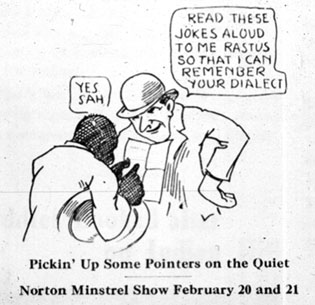
Source: Norton Spirit, 1917.
What did it mean to use St. Patrick's Day as the theme for the 1924 show? 1924 witnessed a battle for control of Worcester's streets between the Ku Klux Klan and its opponents, organized around the Knights of Columbus, an Irish-dominated Catholic fraternal order. By allowing first and second-generation Swedes to join in Worcester, something that did not happen elsewhere, the Worcester Klan explicitly affirmed that American nationality and ethnicity could reinforce one another. So did its arch antagonist, the Knights of Columbus, which regularly labeled the Klan unAmerican. [5]
The Klan had two centers of strength in the city -- Quinsigamond Village, Worcester's largest Swedish neighborhood, and Greendale, home of the Norton Company. The Village was so thoroughly dominated by Swedes that residents used to joke that one needed a passport to cross the bridge on Millbury Street which marked its entrance. The Village had half a dozen Swedish churches, all Protestant, and no Catholic churches. The Norton Company, also a Swedish bastion, sponsored a new club for its employees in 1924, the Ericson Lodge, named after the Swedish-American inventor whose Monitor duelled the Merrimack in the Civil War. The Lodge was a KKK klavern. Some of the Norton workers who "corked up" to "salute" St. Patrick's Day also donned white robes and hoods to protest the Irish influence in Worcester's politics and schools and to denounce their opposition to Prohibition.
It was highly unusual for immigrants to join the Klan. Indeed Klan regulations forbade it. Instead Klan organizers, aka kleagles, would create parallel organizations for Welsh or Scots-Irish or other immigrants who wished to join. The Worcester kleagle, however, opened the Klan to Swedish immigrants. Those who joined proclaimed their Americanism. So did those who attacked them. At the same time, Swedes who joined the Klan via the Ericson Lodge simultaneously proclaimed their ethnicity, as did those who opposed the KKK by joining the Knights of Columbus. In joining the Klan's "Fight for Americanism," in the words of Imperial Wizard Hiram Wesley Evans, as Swedes, the new Knights of the Invisible Empire were enacting a fusion of acculturation and ethnicity which is one of the central themes of this discussion. So too were the Irish Americans who opposed the "unAmerican" KKK by means of a Catholic fraternal order. Their dispute was over both the meaning of "Americanism" and over which ethnic groups were entitled to claim American nationality.
When KKK members in Worcester put on their robes, they became marked men, literally. Anti-klan activists often lay in ambush outside their gatherings. Those opposed to the Klan took down the license plate numbers of those attending; friendly police then supplied them with information about who owned the vehicles. This led to the creation of a listing of Klan members, to its publication, to boycotts of Klan-connected businesses, and to other forms of retaliation, some of them violent. [6]
In October, 1924 there was a Grand Konvocation held at the Agricultural Fair Grounds which adjoined the Norton Company. Thousands of new Knights assembled for a mass induction ceremony. After the meeting, as Klansmen and their families drove away from the Fair Grounds, an anti-Klan mob attacked. Young men jumped upon the running boards of cars, pulled occupants out of them, set some of the vehicles on fire, overturned others, and beat up whomever they got their hands on. Worcester police, most of them Irish, did what they could to prevent actual loss of life. One policeman on a motorcycle drove it into a small mob beating Klan members and rescued them. The police made few arrests, much to the indignation of Worcester's two Republican newspapers, both of which supported the Klan. Those few included several Klan members on weapon possession charges and one Irish-American teenager.
1924 also witnessed an epic struggle within the Democratic Party over the Ku Klux Klan. The Klan endorsed William Gibbs McAdoo, the frontrunner for the nomination. McAdoo was a Southerner by birth who had become a successful New York City lawyer and businessman. During World War I he had served as Secretary of the Treasury. He had also married Woodrow Wilson's daughter. He was Wilson's political heir. And that included Klan support. It was Wilson who agreed to have the initial showing of D.W. Griffith's "Birth of a Nation" at the White House and who endorsed its heroic portrait of the first Klan during Reconstruction. "It's like writing history with lightning. And my only regret is that it is all terribly true." McAdoo in 1924, for his part, issued a statement affirming his support of freedom of religion for all Americans. He did not repudiate the KKK' s endorsement, however. This led Oscar Underwood, Senator from Alabama, and Al Smith, Governor of New York, to challenge him for the nomination. Both denounced the Klan and urged the party to include a plank in its platform condemning it by name. Instead the party, led by the McAdoo supporters, rejected the plank by four votes. Party rules stipulated that a nominee gain two-thirds of the delegates' votes. The bitter division over the Klan showed that none of the leading candidates could muster that number. 102 ballots later there was still no nominee. Finally, exhausted delegates agreed upon John W. Davis of West Virginia. McAdoo's political star waned. So did Underwood's, and Davis's. Anti-Klan activists in Worcester and elsewhere found a champion in Smith. [7]
The Norton Company Minstrel Show, cont.
America is God's
crucible, the Great Melting Pot where all the races of Europe are melting and
re-forming! Here you stand, good folk, your 50 groups, with your fifty languages
and histories, and your fifty blood hatreds and rivalries... A fig for your feuds
and vendettas! Germans and Frenchmen, Irishmen and Englishmen, Jews and Russians
- into the crucible with you all! God is making the American. This
vision of multual adaptation quickly gave way to demands for complete conformity.
Henry Ford, for example, sponsored his own "Melting Pot," as described in the
Ford Times in 1916: This
is not how George N. Jeppson saw matters. Norton Company under his leadership
held an annual folk festival whose centerpiece was a parade of festooned wagons
and cars representing the various nationality groups which made up the work force.
Jeppson
himself headed the Swedish Republican Association of Massachusetts, by far the
largest ethnic political association in the state. He helped organize the annual
Midsummer celebration, a city-wide orgy of Swedish ethnic breast-beating. And
he promoted Swedish folk culture, especially song. In 1920 he brought the first
postwar national convention of Swedish singing societies to Worcester. Norton
Company's Americanization efforts were anything but attempts to stamp out all
traces of ethnic group subcultures. Instead the company openly extolled ethnicitiy.
But it did not regard ethnic groups as all equally valuable. Here are the lyrics
from a comic song written for a company dinner, circa 1908, to be sung to "Tramp,
Tramp, Tramp, The Boys Are Marching," and printed on the menu: In our Norton Foremen's corps, The
song ended with a Swedish-American toast to Jeppson, sung by Swedes and Yankees: A skoal for our leader, George
N. J., Any
version of the "melting pot" is an ideal type, not a description of what actually
happened over the course of the century between the burning of the Charlestown
convent and the Smith-Hoover presidential contest. For that period becoming "American"
meant entering a culture in which European and other nationality groups contended
with each other � as well as with their Yankee "hosts" � for pride of place. [8]
[8] It was a culture which insisted upon the salience of ethnic stereotypes. In
1883, for example, the first Swedish Directory, a compilation of all the
names, addresses, and occupations of Worcester's Swedes, contained this joke,
in Swedish. The priest asks: Patrick,
the widow Murphy says you stole one of her best pigs. Few
of the Directory's readers had been in the United States for more than
a couple of years. Yet they were already learning "Pat and Mike" jokes � in Swedish!.
This suggests that ethnicity itself was a form of acculturation
rather than an alternative to it. To think otherwise � to assume that as members
of a group became more "American," as Norton's Swedish employees leaned to "feel
at home," for example, they became less ethnic, less insistent upon their Swedish
identity � is to adopt the arithmetic of the nativists of the 1910s and 1920s
with their calls for "100% Americanism." Acculturation
and ethnicity could reinforce each other in complex ways. They could also, and
did, work against each other as when American-born children rejected their parents'
"Old Country ways." There was an equally complex interplay between the emerging
national popular culture, as expressed in vaudeville, popular songs, and movies,
and grassroots cultural expressions, as in the Norton Company's Foremen's Dinner
appropriation of "Tramp, Tramp, Tramp, the Boys Are Marching." A
Jewish-American View of Acculturation: "The Jazz Singer"
"Years
later - - and three thousand miles from home," a title reads, "Jakie Rabinowitz
had become Jack Robin - - the Cantor's son, a jazz singer. But fame was
still an uncaptured bubble. . . ." Jack is auditioning before a live audience
in a San Francisco cabaret. He sings one song and then says to the crowd:
Wait
a minute! Wait a minute! You ain't heard nothin' yet. Wait a minute, I tell ya,
you ain't heard nothin'! Do you wanna hear 'Toot, Toot, Tootsie!'? All right,
hold on, hold on. Lou [the band leader], Listen. Play 'Toot, Toot, Tootsie!' Three
choruses, you understand. In the third chorus I whistle. Now give it to 'em hard
and heavy. Go right ahead! [Real Player video available at the Al Jolson Society Official Website. Click
on Works and then on Film.] "You
ain't heard nothin' yet" was a Jolson trademark, a line he had used countless
times, as was the song "Toot, Toot, Tootsie." In the audience is a beautiful woman,
a dancer, who befriends Jack Robin and gets him a job on the same vaudeville circuit
as herself. Jack falls in love. He has not, however, forgotten his first love,
his mother. He writes her regular letters. A title reads: "Dear Mama: I'm getting along
great, making $250.00 a week. A wonderful girl, Mary Dale, got me my big chance.
Write me c/o State Theater in Chicago. Last time you forgot and addressed me Jakie
Rabinowitz. Jack Robin is my name now. Your loving son, Jakie" Signing
the letter in which he reminded his mother of his new name "Jakie" emphasizes
the competing claims on his identity. Is he really Jack Robin or still Jakie Rabinowitz?
In Chicago he attends a concert of sacred songs by a famous cantor. Soon after
he gets his big break, an offer to star in a new show on Broadway, "April Follies."
The titles read: "NEW YORK! BROADWAY! HOME! MOTHER!" He arrives in New York on
his father's sixtieth birthday and rushes from the station to their tenement apartment.
His father is out, but he has a joyful reunion with his mother. He gives her a
diamond necklace, promises that, if the show proves a hit, he will move his parents
up to the Bronx, and sits at the piano and sings for her. It is an Irving Berlin
tune, "Blue Skies." As he finishes the song, his father enters. They renew their
old quarrel. "You dare to bring your jazz songs into my house! I taught you to
sing the songs of Israel � to take my place in the synagogue!" Jack retorts: "You're
of the old world! If you were born here, you'd feel the same as I do � tradition
is all right, but this is another day! I'll live my life as I see fit!" All
of the dichotomies dissolve. The Yom Kippur service and the Broadway show both
go on. Cantor Rabinowitz's son fulfills the family tradition and realizes his
ambition to live his own life. Jakie Rabinowitz can be Jack Robin and Jakie Rabinowitz
can be Jack Robin. He can please his Jewish mother and his gentile girlfriend. The
exchange between Jakie and his father on the latter's birthday is especially sailent
in this context: Cantor
Rabinowitz: You dare to bring your jazz songs into my house! I taught you to sing
the songs of Israel � to take my place in the synagogue! Jack:
You're of the old world! If you were born here, you'd feel the same as I do �
tradition is all right, but this is another day! I'll live my life as I see fit! Jack's
retort that, if his father had been born in the U.S., he'd feel as Jack does,
directly contradicted one of the most important anti-semitic claims of the time.
This was that, as Hiram Wesley Evans, Ku Klux Klan Imperial Wizard, phrased it,
"not in a thousand years of continuous residence would he [the Jew] form basic
attachments comparable to those the older type of immigrant would form within
a year." Evans explained in a Klan Day address at the Texas State Fair in Dallas,
October 24, 1923: As
a race the Jewish are law abiding. They are of physically wholesome stock, for
the most part untainted by immoralities among themselves. They
are mentally alert. They are a family people, reverently and eugenically responsive
to God's laws in the home. But their homes are not American but Jewish homes,
into which we cannot go and from which they will neverr emerge for a real intermingling
with America. [9] The
adverb "eugenically" is particularly revealing. Evans hitched the Klan's claims
to intellectual respectability to the emerging science of Eugenics. Historians
pay too little attention to the eugenics
movement of the first third or so of the twentieth century
and less to the biological research upon which it was based. [10]
But Eugenics, the study of how to identify good and bad "stock," was taught in
high school and college curricula across the country. Virtually every biology
textbook devoted at least a chapter to it. At its core was the notion, borrowed
from the early nineteenth-century thinker Lamarck, that acquired characteristics
could be inherited. Thus, in Frederick Jackson Turner's celebrated "frontier thesis,"
the experience of "opening" the frontier shaped the American character. In Evans'
view, thousands of years of persecution had similarly but more deeply imprinted
certain traits upon the Jews. The "indelible impress" of persecution "is there,
marked by generation after generation of unchanging and unchangeable racial characteristics."
Among these is an inherited inability to feel patriotism. "For ages . . . he has
been a wanderer upon the face of the earth. . . .Into his life has come no national
attachment. To him, patriotism, as the Anglo-Saxon feels it, is impossible." To
this "The Jazz Singer" offers a dramatic rebuttal. It does so by making Jakie
want to sing "American" songs. Who wrote this "American" music? Irving Berlin,
another immigrant Jew, for one. Purists
have been quick to point out that Jolson was not a "jazz singer" and that neither
"Waitin' for the Robert E. Lee" nor "Blue Skies" were jazz songs. Louis Armstrong,
they note, was inventing a whole new way of singing in the late 1920s, as he had
of playing, which would shape jazz for decades. Armstrong, Duke Ellington, Fats
Waller, James P. Johnson and others were inventing jazz music. Irving Berlin did
not write jazz. On the other hand, the movie took the time to indicate exactly
what a "Jazz Singer" was. Jakie gave his mother a demonstration. He sang the Berlin
song straight and then "jazzed it up," i.e., speeded up the tempo. [An extended
digression on the early use of "authentic" jazz in the movies is here.] There
is another dimension to the way the movie used the term "jazz." A few years earlier
Henry Ford, as part of his crusade
to eliminate the Jewish influence in American life, singled out Berlin and jazz
music as especially pernicious threats. Jews, led by Berlin, now controlled the
music publishing houses, he charged first in the pages of his Dearborn Independent
and then in The International Jew: The World's Foremost Problem. They used
this power to drive out genuine "American" music and to substitute the "mush"
and "slush" of jazz which appealed only to the "basest" tastes and instincts.
Just as Jakie's outburst about being born in America and therefore wanting to
sing "American" music was a riposte to eugenics advocates who claimed Jews could
not feel patriotism, the film's choice of a title and of a Berlin song to exemplify
American music directly challenged Ford's anti-Semitic claims. Jerome Kern, himself
a Jew, put the matter succinctly. Asked to comment on Irving Berlin's "place"
in American music, he responded: "Irving Berlin doesn't have a 'place' in American
music. Irving Berlin is American music." Becoming
"American," "The Jazz Singer" asserted, does not require the repudiation of one's
ethnic heritage. Acculturation can, and should, accommodate ethnicity. This is the
same claim Norton Swedes and Worcester Irish Catholics made, the former in joining
the KKK via the Ericson Lodge, the latter in opposing the KKK by joining the Knights
of Columbus. Both saw their actions as asserting their essential American identity
even as they continued their long and bitter rivalry. Both also routinely staged
minstrel shows. "Passing from light into dark" was a way of staking the claim
that ethnic identity was no obstacle to being a real American. Race was. An
extended digression on another "jazz singer": Eddie Cantor and making "Whoopee!"
Cantor,
like Jolson, was the son of Jewish immigrants. He too grew up in the "ghetto"
on the Lower East Side and then went into vaudeville. He too became a star. While
Jolson specialized in the big sentimental ballad, like "Mammy" or "Sonny Boy,"
Cantor's forte was comedy, usually slightly risqu�. In "Whoopee!" for example,
his nurse has followed him to a nearby settlement. Henry is disguised in blackface,
thanks to a comic accident with a stove. She too is in disguise, as a cowboy complete
with mustache. She immediately recognizes Henry and accuses him of loving Sally.
Henry, who does not recognize her, protests that he does not. Relieved and overjoyed,
Mary offers to kiss him. "Hey, what sort of cowboy are you anyway?" is Henry's
startled reply. Like
Jakie Rabinowitz, Cantor, born Edward Israel Iskowitz, changed his name when he
went into show business. The name he chose identified both his ethnic background
and his ambition to be a singer. Yet Henry Williams was supposed to be a WASP
with inherited millions. When Henry gets into trouble, he too passes "from light
into dark," first pretending to be African American and then Indian. In the latter
guise, to keep from being found out, he adopts a thick Jewish accent. A Jew, playing
a Yankee pretending to be an Indian, spoke a combination of broken English and
Yiddish. And the audiences loved it. This came as no surprise. Fanny Brice, another
Jewish-American vaudeville star, who, like Cantor, often headlined with Ziegfeld's
Follies on Broadway, was almost as well known for her "Look at Me, I'm an Indian,"
sung in a thick Jewish accent, as for "Second-Hand Rose." Giving
the bit a further spin, Henry Williams spoke like a Jewish immigrant peddler as
he bargained over the price of a rug. Had a gentile played Williams, the scene
would have proved highly offensive to Jewish members of the audience. But everyone
knew Cantor was "passing" as a gentile. In case they didn't, the show incorporated
several jokes where Cantor's background is made explicit. In one, Wanenis is lamenting
that, despite all of his attempts to adopt the white man's ways, Sally's father
will not accept him. "I even went to your schools," he says. "You went to Hebrew
School?" Henry responds. Following
the stock market crash, Cantor collaborated with artist Sid Hydeman on Caught
Short, a set of comic sketches about buying stock "on the margin" during the
great bull market and then watching one's investments turn to dust. In one cartoon,
Cantor books a hotel room on the nineteenth floor. The clerk asks: "Do you want
it for sleeping or jumping?" Cantor described himself on the title page as "comedian,
author, statistician, and victim." The subtitle puns on the "Wailing Wall," a
place sacred to Jews. The cartoon on the facing page is a pun as well, a "coon"
joke which also pokes fun at a well-known Jewish investment bank. It was the sort
of "fresh material" the minstrel in the Norton Spirit cartoon of 1917 was
seeking. Consider
in this context the "Parade of the Horribles" at the annual Field Day sponsored
by the American Steel and Wire Company in Worcester in the years surrounding World
War I. Who were the "Horribles"? They were employees dressed up in bizarre costumes,
often with ethnic and/or racial themes. The most "horrible" won a prize. In 1921
the winners were the "South Works Cannibals," complete with grass skirts, spears,
cork make-up, and earrings, pictured here as photographed for the Company newsletter.
The
South Works were located in Quinsigamond Village, the most Swedish section of
Worcester. Some of the "Cannibals's" sisters, members of the Swedish Women's Gymnastic
Club, put on semi-annual shows for charity in the much more refined precincts
of Tuckerman Hall, home of the Worcester Women's Club. The first portion of these
shows, which attracted large audiences and significant coverage in the English-language
newspapers, consisted of an exhibition of Swedish gymnastics. After intermission
came a musical review, loosely modelled upon Ziegfeld's Follies. The gymnasts
too were attracted to the South Seas. On other occasions, they chose to be geishas,
or Swiss
Misses, or Little
Dutch Girls. Like their brothers among the "Cannibals," they
presumably harbored no malice toward the Japanese or the Swiss or the Dutch or
South Sea Islanders. They were simply looking for colorful costumes and a theme
for their performances. [11]
Where
did the "Horribles" get their notions of "Cannibals"? From the same sources the
gymnasts got theirs of South Sea maidens. They appropriated the grass skirts,
the ukeles, the leas and floral headdresses from the movies and popular literature.
So too the spears and the blackened skin of the "Cannibals." The idea of staging
a "revue" in exotic � albeit decorous � costume came from Broadway. During the
1920s "revues" overshadowed musical comedies. In 1928, for example, Time
chose Florenz Ziegfeld, Jr. as its "Man of the Year." [For an extended discussion
of "revues," see "Revues and Other
Vanities: The Commodification of Fantasy in the 1920s." This is part of a
project on "American History and Culture on the Web," supported by a grant from
the National Endowment for the Humanities.] Some
forms of ethnic and racial play hit closer to home. One was a "Comic Boxing Match,"
also staged during the 1921 Field Day and described in the American Steel and
Wire newsletter. It pitted "Swen Sullivan of Italy" against Patrick Mohammed,
the Polish Wonder." On the face of it, this might appear a playful representation
of the Company as a melting pot � a fusion, perhaps a confusion, of Swede, Irish,
Italian, Syrian, and Pole. But Patrick and Swen were comic figures precisely because
everyone on the field that day knew there could never be an Irish Syrian from
Poland. And a Swedish Irishman? About as likely as a Native American speaking
Yiddish. The referee was "Jack Johnson," who strode into the ring carrying a three-foot
razor with which to enforce his decisions. Here was one
stereotype upon which all others could agree. The real Jack Johnson had been the heavyweight champion
against whom a succession of "great white hopes" had contended. He would have
needed no razor. [12] His presence,
however, reminded everyone � Swedes, Irish, Italians, Syrians, and Poles alike
� that just like "Jack Johnson" and "Rastus," they too were first and foremost
perceived as stereotypes before they were individuals. Perceived by whom? Instead
of answering "by the host culture," we should recall that everyone attending the
Field Day was familiar with the ethnic stereotypes sent up in the "Comic Boxing
Match." This
makes Cantor's use of Yiddish while playing a WASP pretending to be an Indian
so daring. In playing with stereotypes he was playing with fire. It also explains
the "Kuhn/coon" joke and the pun on "wailing Wall Street." Jews, like other nationality
and ethnic groups, had to come to terms with stereotypes, often highly insulting,
about themselves. Jews stereotypically worshipped money. They also controlled
international finance, if Henry Ford were to be believed. So Cantor, self-described
"victim" of the crash, wore his ethnicity on his sleeve. He also reminded white
readers of the difference between "Kuhn" and "coon." "Swen Sullivan of Italy"
and "Patrick Mohammed, the Polish Wonder" represented a similar form of play. Cantor
moved into radio with a long-running comedy program the year after he made "Whoopee!"
A few years later another second-generation Jewish comedian, Jack Benny, scored
an even greater success. Like Cantor in "Whoopee," Benny played a gentile, and
also one with a character trait stereotypically associated with Jews. He worshipped
money. Benny got the longest laugh in radio history with this gag: Stick-up man: "Your money or your life!" Benny,
unlike Jolson and Cantor, did not appear in blackface. Instead he cast Eddie Anderson
as his black valet, Rochester. Over the decades, Rochester became less and less
a stereotype. But Benny's miserliness became more pronounced each season as his
writers looked for new ways to tell the same jokes. In one episode, a Treasury
official from Fort Knox visited Benny to observe his security measures. These
included surrounding his vault with a moat complete with alligators. Here again
the jokes worked because the audience was complicit. They knew that Benny was
Jewish. They knew through fan magazines and newspaper gossip columns of his personal
generosity. Benny, like Cantor in "Whoopee!" and Jolson in "The Singing Fool,"
"passed" as a gentile. None used makeup. Benny did turn his blue eyes � in the
1920s, '30s, and '40s used in Nazi propaganda as a sign of Aryan origin � into
a standing joke. His character was as vain as he was greedy. And he was especially
vain about how blue his eyes were. Benny,
in addition, affected distinctive vocal rhythmns along with matching gestures,
facial expressions, and walk. These too involved the audience
as accomplices as all were stereotypes associated with gay men. Benny employed
them in his character's endless efforts at seducing women. This too stood "passing"
on its head. [13] Michael
Rogin is right, I think, to argue that blackface provided
a way for Jewish immigrants from Europe and their American-born children to claim
membership in American nationality. [14]
Yet, their appropriation of minstelsy is part of a much wider phenomenon as the
examples of the shows put on by Norton Company and by Irish-Catholic parishes
suggest. Nor was blackface solely or even primarily a way for ethnic groups to
assert their own place in American public life, even though it certainly could
fulfill that function. We
still think the "Perfect Song,"
which was written for "The Birth of a Nation," a perfect song for the theme melody
of "Amos 'n' Andy." � Freeman Gosden and Charles Correll, "If
we had it to do OVER AGAIN": A Great Radio Pair Look Back Over Their Career
on Their Fourteenth Anniversary, Movie Radio Guide, March 1942 [For a midi
recording, click here. For a image
of the cover of a 1937 edition of the sheet music with Gosden and Correll in blackface,
click here.] Part
1 | Part 2
| Historiographical
Essay
The
1917 Norton Company Minstrel Show presaged these antagonisms, and the reinforcing
relationship between acculturation and ethnicity. Immigrant workers learned that
one could "black up," that is, pass from light into dark, in a spirit of wholesome
fun that the entire family would find amusing because white Americans knew that
African-American speech and appearance were intrinsically comic. Note, for example,
the way the Norton cartoonist made "Gilbert" and his cat share several facial
features. The Irish jokes, told in the same make-up, demonstrate that learning
how to "blacken" each other's reputation was another routine part of the acculturation
process. The Irish, for their part, had learned this as well. They too put on
minstrel shows, usually parish church productions, throughout the first decades
of the twentieth century in which they routinely made sport of other ethnic groups.
The front page of the [Worcester Catholic] Messenger for March 2, 1906,
for example, told of the great success of the St. Anne's show in which "The German
School" segment had followed the "Rufus Rastus Johnson Brown" and "Holy Cross
'Choo-choo'" numbers. The following year "the boys of St. John's Lyceum" put on,
according to the Messenger, "probably the best amateur minstrel show chorus
seen in Worcester in recent years." One of the highlights was John F. Putnam's
rendition of "an Indian song, 'Big Chief Battle Ax.'"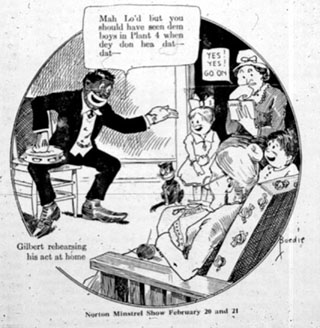
Source:
Americanization,
as contemporaries used the term, referred to the ongoing adaptation of immigrants
and their children to "American" ways. Led by Theodore Roosevelt, who campaigned
for the 1916 Republican presidential nomination on a platform calling for military
Preparedness and the complete obliteration of any sentiment of ethnicity, those
who questioned the loyalty of "hyphenated" Americans assumed that loyal Americans
were, in T.R.'s phrase, "pro-America, first, last, and all the time, and not pro-anything
else at all." Such "100% Americanism" made identity a zero-sum issue. An Italo-American,
for example, was only 50% an American. Acculturation would reduce that 50% to
zero. In such a scheme, any adoption of "American" ways meant a corresponding
loss of ethnicity. The original notion of a "melting pot," in which each "ingredient"
contributes something to the American national identity, was expressed at the
conclusion of Israel Zangwill's 1907 play of that name:
People Who Came to America as Seen Through Objects,
Prints, and Photographs at the Smithsonian Institution
(New York, 1976),
373.
The
"Melting Pot" exercises were dramatic in the extreme: A deckhand came down the
gang plank of the ocean liner, represented in canvas facsimile. "What cargo?"
was the hail he received. "About 230 hunkies," he called back. "Send 'em along
and we'll see what the melting pot will do for them," said the other and from
the ship came a line of immigrants, in the poor garments of their native lands.
Into the gaping pot they went. Then six instructors of the Ford school, with long
ladles, started stirring. "Stir! Stir!" urged the superintendent of the school.
The six bent to greater efforts. From the pot fluttered a flag, held high, then
the first of the finished product of the pot appeared, waving his hat. The crowd
cheered as he mounted the edge and came down the steps on the side. Many others
followed him, gathering in two groups on each side of the cauldron. In contrast
to the shabby rags they wore when they were unloaded from the ship, all wore neat
suits. They were American in looks. And ask anyone of them what nationality he
is, and the reply will come quickly, "American!" "Polish-American?" you might
ask. "No, American," would be the answer. For they are taught in the Ford school
that the hyphen is a minus sign.
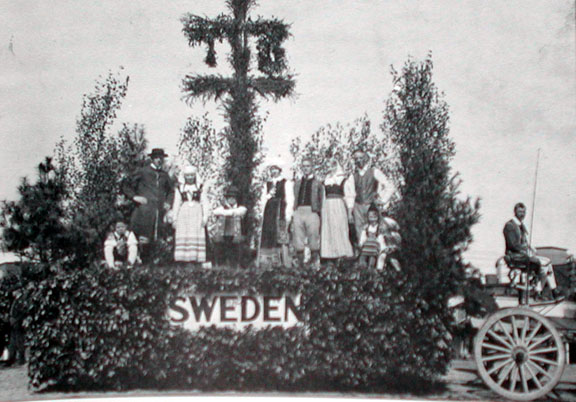
There are Yanks and Swedes galore,
But hardly an Hungarian, Italian, or Pole
. . .
Hip, Hurra,
He is the man that sets the pace,
He is the man
that steers us straight.
Yes, Father.
What
have you done with it?
I slaughtered it and ate it up, Father.
Oh, Patrick,
what will you answer on Judgment Day when you stand face-to-face with the widow
and her pig and she accuses you of having stolen it?
Father, did you say
the pig will be there?
Yes, of course I said that!
Well then, I would
answer: "Mrs. Murphy, now you have your pig back!"
One
can see many of these interrelationships at play in "Warner's Bros. Supreme Triumph,"
"The Jazz Singer." The first "talkie," it was based "The
Day of Atonement," a short story by Samson Raphaelson. In
the movie Al Jolson played Jakie Rabinowitz, son
of Jewish immigrants. His father is a cantor in a synagogue on the Lower East
Side of New York City who expects Jakie to follow in his footsteps. But Jakie
wants to sing "American" music. On the evening of Yom Kippur, a thirteen-year-old
Jakie is supposed to sing the Kol Nidre for the first time with his father. A
neighbor brings the unwelcome news that Jakie is instead singing "raggy time"
songs at a saloon. Cantor Rabinowitz, outraged, finds Jakie performing "Waitin'
For the Robert E. Lee," one of Jolson's signature songs. He drags his son off
the stage. Determined to teach Jakie a lesson for "debasing" the voice God gave
him, the father administers a thorough beating (off screen). Jakie runs away,
taking only a picture of his mother.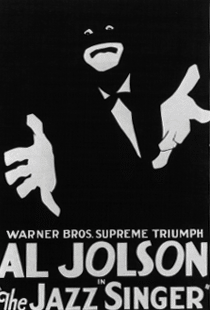
A
few weeks later a neighbor seeks Jack out at rehearsal. "Tomorrow, the Day of
Atonement - they want you should sing in the synagogue, Jakie . . . your father
� he is very sick � since the day you were there." Jakie replies: "Our show opens
tomorrow night � it's the chance I've dreamed of for years!" The neighbor bursts
out: "Would you be the first Rabinowitz in five generations to fail your
God?" Jakie says: "We in the show business have our religion, too � on every day
� the show must go on!" Here is the choice: Is he Jakie Rabinowitz, the
cantor's son, or Jack Robin, the jazz singer? His mother visits him backstage
to tell him that his father is dying and that his last wish is that Jakie sing
the Kol Nidre. Mary Dale reminds him of his commitment to his career. Jakie tells
his mother he must seize his chance to become a star. He goes off to rehearse
his big number, and his mother leaves. He goes after her. He sees his father who
tells him: "My son � I love you." Mary and the show's producer turn up. Will Jakie
sing in the synagogue? The producer tells him that, if he does, it will be the
end of his career.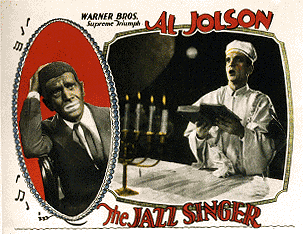
The
film cuts to the theatre. It is opening night. "Ladies and Gentlemen, there will
be no performance this evening �" The film cuts to the synagogue where Jakie is
leading the service. His father's dying words are: "Mamma, we have our son again."
The next night the show opens, and Jack Robin scores an enormous triumph. The
movie closes as, in blackface, he sings "Mammy" to his mother in the audience.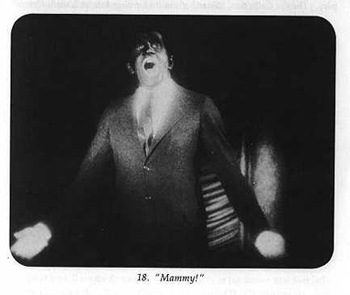
Based
upon Owen Davis's comedy, "The Nervous Wreck," the musical comedy "Whoopee!" was
a big hit on Broadway in 1928. Produced by Florenz Ziegfeld, it starred Eddie
Cantor. It was filmed in 1930, with Ziegfeld and Samuel Goldwyn as co-producers
and with virtually the entire Broadway cast recreating their roles. Cantor played
Henry Williams, a neurasthenic who heads to a dude ranch in Arizona along with
his nurse, Mary Custer, in search of peace and quiet. In a parallel plot Wanenis,
the son of an Indian chief, loves a white heiress, Sally Morgan, whose father
has forbidden their marriage. Henry finds himself accused of running off with
Sally when her attempt to elope with Wanenis fails. She has left a note in which
she writes that she and Henry have eloped. Since Sally's other suitor is the local
sheriff, Henry seeks refuge on the reservation, where disguised as an Indian,
he bargains over the price of a rug with a tourist. How can he stay in disguise?
As soon as he opens his mouth, he will reveal himself as a white man. Henry hits
upon a solution that made the scene the most celebrated of the film's many comic
bits. He speaks Yiddish! All ends happily when it turns
out that Wanenis is not really an Indian; he was merely raised as one. Since race
and not acculturation is what counts, he and Sally can now marry. Henry, for his
part, finally realizes that his nurse loves him, and they too marry. Marriage
solemnizes racial purity; a trope Hollywood used over and over.

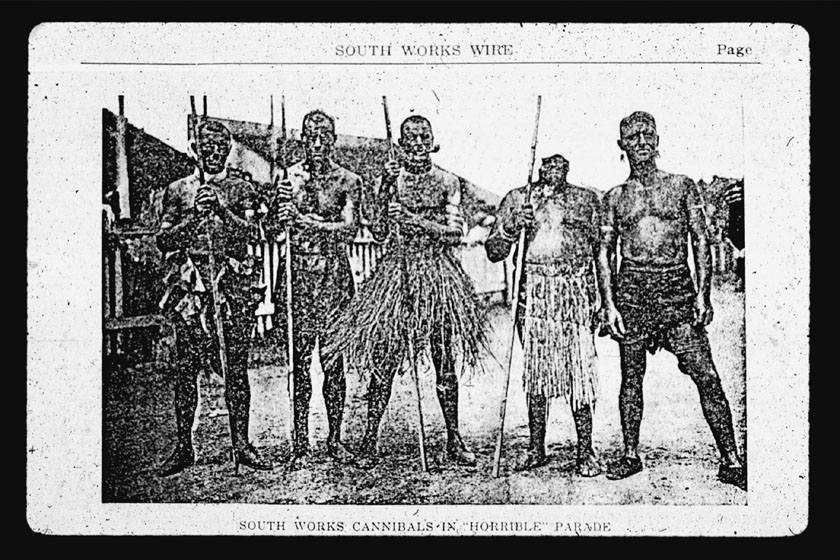
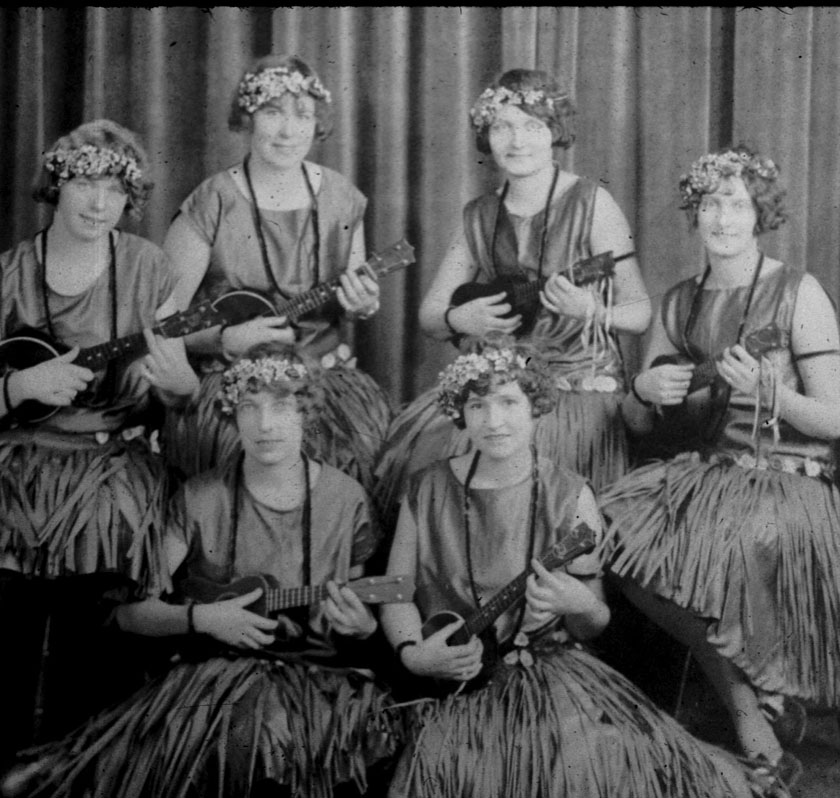
Benny: [a long
silence]
Stick-up man: "I said 'Your money or your life!'"
Benny [peevishly]:
"I'm thinking! I'm thinking!"
- The
description of the Norton Company Minstrel Show and Americanization efforts draws
upon Charles W. Estus, Sr. and John F. McClymer, g� till Amerika: The Swedish
Creation of an Ethnic Identity for Worcester, Massachusetts (Worcester, MA.,
1994), 66-96; Norton Company Archives, Worcester Historical Museum (uncataloged);
"g� till Amerika" exhibition curators' notebooks, Assumption College Community
Studies archives.[Return]
- Based upon Edna Ferber's novel, Show boat, (1926) which was adapted by her, Max Dunn, and Oscar Hammerstein, Jr for the 1927 musical. [Return]
- Eric Lott, Love & Theft, Blackface Minstrelsy and the American Working Class (New York, 1993).[Return]
- See John F. McClymer, �A Battle of Parades: �National Days� and Swedish-Irish Competition in Worcester, Massachusetts, 1880-1920,� Migrants and the Homeland Symposium, Uppsala University, Sweden, 12-14 June 1996, published in Migrants and the Homeland: Images, Symbols, and Realities (Uppsala, 2000), 123-141.[Return]
- Timothy J. Meagher, Inventing Irish America : Generation, Class, and Ethnic Identity in a New England City, 1880-1928 (Notre Dame, IN, 2001) is the definitive work on the Irish in Worcester; on the Klan in Worcester, see g� till Amerika, 122-143. This account of the Irish-KKK hostilities draws upon this latter source.[Return]
- The violence is detailed in g� till Amerika, 131-38. There are several sources for determining KKK membership in Worcester, all imperfect. One is "A bona-fide partial list of members of the Ku Klux Klan. These names were submitted for publication by a former officer of the organization in Worcester County." This was a broadside, distributed anonymously throughout the city in 1924. A photocopy is in the Assumption College Community Studies archives. It is highly unlikely the names on the list were supplied by a former KKK official. Anti-Klan activists staked out Klan meetings and copied down license plate numbers. It is likely the names were culled from another list generated in this fashion. This list took the form of a series of checks next to names in a 1923 Worcester City Directory and provides a second source of KKK membership. Since not every KKK member owned a car, much less drove it to a meeting, it is incomplete. It can be supplemented by a third source, a ledger kept by the Klan recruiter who signed it "J.W." Photocopies of both are in the Assumption College Community Studies archives. Use is restricted. No names of individuals can be cited.
The first source, as indicated, contains no names not checked in the 1923 City Directory. The Directory provides 2,365 names of Worcester residents plus 1,085 names of those living in surrounding towns. The ledger contains 588 names. Klan recruiters received a percentage of the entry fee for each new member. This provided them with a financial incentive to fail to record all the new members since they could then simply pocket the fee. In addition, there were other ways to join. One could apply directly to a klavern, for example. What this means is that the membership records are incomplete and, in some cases, inaccurate. Since, however, there are several other places for which partial membership lists have been discovered, it is possible to compare Worcester data with that from the Mahoning Valley in Ohio in William D. Jenkins, Steel Valley Klan: The Ku Klux Klan in Ohio's Mahoning Valley (Kent, OH, 1990) and in Leonard J. Moore, Citizen Klansmen: The Ku Klux Klan in Indiana, 1921-1928 (Chapel Hill, NC, 1991). The Worcester data yields the same membership profile as those found by Jenkins and Moore. See Charles W. Estus, Sr. and John F. McClymer, "'Little Dutch Girls and Imperial Knights" Appendix: Sources for Membership of the Worcester Klan, The Swedish-American Historical Quarterly (January, 1996), 36-39. This draws upon Kevin L. Hickey, "The Immigrant Klan: A Socio-Economic Profile of the KKK Membership in Worcester, Massachusetts, 1922-1925," paper read at the meeting of the American Association of Geographers on 20 April 1981. [Return]
- The standard account is David Burner, The Politics of Provincialism: The Democratic Party in Transition, 1918-1932 (New York, 1968). See also Lee N. Allen, "The McAdoo Campaign for the Presidential Nomination in 1924," The Journal of Southern History (May, 1963), 211-228. [Return]
- Stanley Lieberson, A Piece Of The Pie: Blacks and White Immigrants Since 1880 (Berkeley, CA, 1980) applies what Lieberson labels "queuing" theory to explain the differential access various immigrant groups and African Americans had to housing, jobs, and other opportunities. In the absence of anti-discrimination legislation, employers hired whom they pleased; real estate owners rented to whom they pleased; and so on. How a given individual fared depended, to a considerable extent, upon his or her group's position in the queue. White Protestants stood first. African Americans stood last. And other groups elbowed each other to move up on the line. [Return]
- Available at the Ku Klux Klan Special Collection at Michigan State University. [Return]
- Despite its palpable importance, historians and other scholars have paid little attention to the eugenics movement. Textbooks barely mention it. Ann Douglas's Terrible Honesty: Mongrel Manhattan in the 1920s (New York, 1995), despite the subtitle which comes directly from eugenics, does not refer to it at all. In this she merely follows the well-trod trail blazed by Frederick J. Hoffman in his The 20's: American Writing in the Postwar Decade (New York, 1949). Lynn Dumenil, The Modern Temper: American Culture and Society in the 1920s (New York, 1995) mentions eugenics on in passing in a comment about Margaret Sanger. Nancy MacLean does discuss eugenics in her Behind the Mask of Chivalry: The Making of the Second Ku Klux Klan (New York, 1994) but only briefly and in a highly misleading way. She writes:
The Klan shared a commitment to pseudo-scientific breeding with large numbers of contemporaries across the political spectrum. Still, there was a difference. The order's virulent racialism led it to apply eugenics in an especially dehumanizing, ghoulish manner. One Klan leader and minister thus maintained that "the methods employed in stock-raising" should be applied to human reproduction. He envisioned "elimination of the unfit" people and races from sexual activity and "development of the fit to the highest degree through the process of scientific study."
In fact, the Klan's version of eugenics was altogether orthodox. The precise features MacLean cites as "especially dehumanizing" and "ghoulish" were ones all eugenicists embraced. There is, however, the newly published Wendy Kline, Building a Better Race: Gender, Sexuality, and Eugenics from the Turn of the Century to the Baby Boom (Berkeley, CA, 2002). [Return]
- Alice Johnson, a long-time member of the Swedish Women's Gymnastic Club, lent her collection of English and Swedish-language newsclippings and several photographs to the "g� till Amerika" exhibition. All information is from this source. See Curators' Notebooks. [Return]
- Al-Tony Gilmore, Bad Nigger! The national impact of Jack Johnson (Port Washington, NY, 1975). [Return]
- For a fascinating but altogether humorless analysis, see Margaret T. McFadden, "'America's Boy Friend Who Can't Get a Date': Gender, Race, and the Cultural Work of the Jack Benny Program, 1932-1946," The Journal of American History (Jun., 1993), 113-134. [Return]
- Michael P. Rogin, Blackface, White Noise : Jewish Immigrants in the Hollywood Melting Pot (Berkeley, CA, 1996). I discuss Rogin's work extensively in the historiographical appendix. [Return]
- Melvin Patrick Ely, The Adventures of Amos 'n' Andy : A Social History of an American Phenomenon (New York, 1991). [Return]
~ Continued in Part 2 ~
Copyright © 2003 by The Journal for MultiMedia History
Comments | JMMH Contents - Based upon Edna Ferber's novel, Show boat, (1926) which was adapted by her, Max Dunn, and Oscar Hammerstein, Jr for the 1927 musical. [Return]